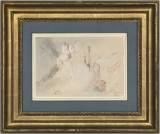This dramatic sheet was made by Turner during a Continental trip in either 1841 or 1842, showing the Burg Eltz form the south, Turner has captured the theatrical profile of the castle, using limpid watercolour washes to suggest the shifting weather. This boldly worked watercolour was made towards the end of Turner’s career, as he explored effects of atmosphere and climate on landscape with ever greater formal and technical freedom. This sheet comes from a dismembered sketchbook Turner was using on a trip to Switzerland and Germany and was almost certainly made on the spot.
The Eltz is a tributary of the Mosel, which it joins at Moselkern. In his 1824 Rivers Meuse and Moselle sketchbook (Turner Bequest CCXVI) Turner made notes from Alois Schreiber’s Traveller’s Guide down the Rhine, a copy of which he owned.[1] Here he underlines Eltz (he calls it ‘Elz’) as a place to remember. Burg Eltz is remarkable for its picturesque situation, perched on the top of a two hundred foot high rock and with its turrets and battlements, the castle affords an air of both the magical and the impenetrable; indeed the stronghold has never been taken by force. In 1840 Turner visited Eltz for the first time, on that occasion he saw the castle from the ruins of Trutzeltz, where a viewing platform had been specifically constructed to allow visitors to admire Burg Eltz from a distance. Two boldly coloured watercolours of this view survive in the Turner Bequest.[2]
The present watercolour was made on his return to Eltz in either 1841 or 1842 and forms part of a group of five sheets that record the castle from multiple different angles. As Celia Powell has noted, on this occasion Turner was able to get much closer to the castle and he took the opportunity to explore it thoroughly, ‘walking right round the rock on which it stands.’[3] During this visit Turner used a sketchbook in which one side of each leaf he prepared with grey wash after the book was bound. The washes vary from dense and dark to relatively light and sometimes Turner chose to work on the prepared surface, sometimes on the unprepared side. In this sheet Turner used the prepared, grey washed side of the paper, enjoying the surface it gave him.
To circle the castle Turner must have clambered over rocks and through trees and undergrowth. It seems that he also contended with rain, Turner has shown rain sheeting down on the left-hand side of the watercolour and in a second sheet made at the same time a rainbow over the castle. In common with other sheets of this period, Turner rapidly, but carefully described the distinctive outline of the castle in pen and red ink, building up the composition with areas of rich wash, to capture the light hitting the castle, He also used scratching-out taking full advantage of the mid-tone provided by the grey washed paper. This method of overlaying transparent watercolour washes with sharper filaments of ink was much praised by Ruskin. Turner brings the foreground of this magical, small study to life with this suggestive red ink forms.





